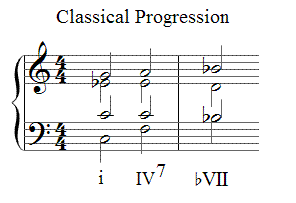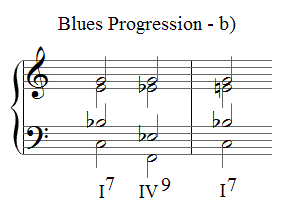APPENDIX A: VOICE LEADING OVERVIEW
The Blues 7th
The earlier section on the emancipation of the dominant 7th chord explained how the rule about the preparation of the 7th of the dominant chord was relaxed during the 17th century and how this lead to a whole series of new chord progressions and melodies. A similar relaxation of the rules of voice leading in the 20th century contributed to the sound of the blues and made possible the 12 bar blues progression.
The three 7th chords used in the blues (I 7, IV 7 and V 7) would be treated, in classical tonality, as discords that have to be prepared and/or resolved in a standard way. However, in the blues, the 7ths of these chords are treated as consonances. i.e. as essential components of the chord. This means that they do not necessarily require preparation or resolution. This is not just a change in chord syntax but also a change in voice leading and results in a different musical effect. The blues effect is thus created by a combination of: the scales used; the way that the 7ths are used (chord syntax) and different voice leading rules. These, and other factors, all affect the sound of the blues - at least on keyboard instrument with fixed tuning.
If we take the example of the chord IV 7, prior to the blues, then the flatten 7th of the chord had to be prepared and resolved. It was viewed in classical harmony as an example of a secondary dominant and had to be properly prepared and resolved as follows:

I've used the small i to represent the minor tonic chord. The Eb is needed to prepare the Eb discord in the chord IV. The Eb is then resolved onto the D of the bVII chord (Bb). This meant that this chord could only be used in special circumstances in classical tonal harmony.
The blues allowed both the major and minor 3rd to coexist in the its scale, so the following was possible:

Here the 7th of the chord IV 7 is neither prepared nor resolved, instead we find a "bluesy" chromatic voice leading as follows:
E natural - E flat - E natural
This would not be allowed by the normal classical rules of voice leading and is therefore unique to the blues and contributes to the bluesy effect of the chord progression.
If we add a 9th to the chord IV then we get the following common blues chord progression:

Like the seventh of the chord, the ninth is treated as an essential part of the chord. The seventh is used without preparation or resolution and whilst the 9th here is prepared by its presence in the preceding chord, it is not followed by the resolution that would normally be required in classical music. Note also, in this progression, the 7ths (in the lower voices) are allowed to move in parallel - a further relaxation in the rules of voice leading.
This has a very important consequence for blues harmony. It is possible to have the static harmony patterns:
I - IV 7 - I
I - IV 9 - I
I 7 - IV 9 - I7
etc.
These progressions were not possible prior to the blues and just as the emancipation of the dominant 7th chord in the 17th century enabled unlimited new melodic possibilities, this changed enable an endless number of new melodies which incorporated harmonic and voice leading patterns from the blues and the blues progression.
This is the quintessential blues harmony and in all the variations of the blues progression, this is the most constant constituent of the progression. It produces the juxtaposition of the major 3rd of the scale (E natural, in the example above) in chord I with the minor 3rd of the scale (Eb) in chord IV 7. This juxtaposition can occur within the melody or between the melody and the harmony and is the defining component of the blues sound especially as handed down to genres influenced by the blues and blues played on fixed pitch instruments such as the piano.
The reader should not assume that in blues voice leading anything goes. Quite the opposite, the patterns in the way the chords and voice leading work together are adhered to consistently, it's not the freedom per se that creates the blues sound but the particular chord and voice leading patterns etc that are used. In fact, the 12 bar blues progression is one of the most consistently applied chord and voice leading patterns in all popular music.
For more about the blues progression see section 12 bar blues progression.
Next Topic: Parallel 7ths in Jazz

